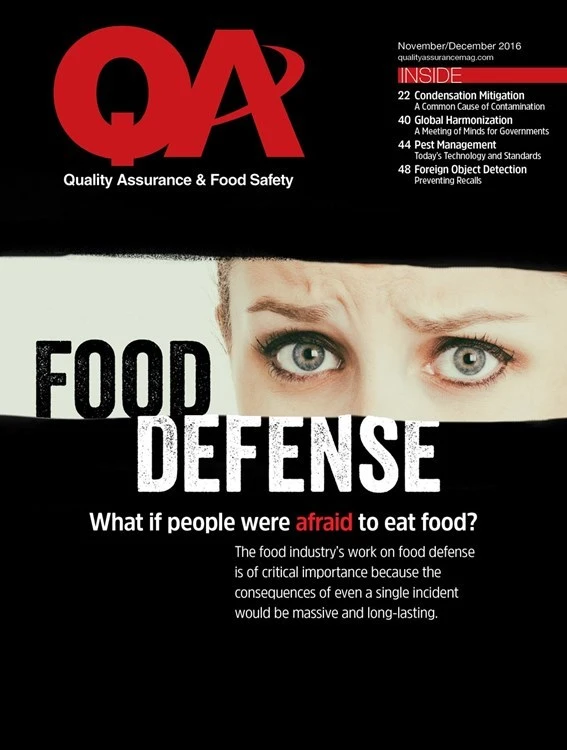By Lisa Lupo
The offices of the Food Protection and Defense Institute (FPDI) sit, aptly enough, on a corner of the University of Minnesota (U of M) campus just across from the agronomy and cattle buildings — in a building that was built in 1904 as the university’s Livestock Pavilion and was, for many years, considered one of the most outstanding animal husbandry facilities in the U.S.
Formerly the National Center for Food Protection and Defense, FPDI was launched in July 2004 as a Department of Homeland Security Center of Excellence to be a multidisciplinary and action-oriented research consortium. FPDI addresses the vulnerability of the nation’s food system, taking a comprehensive, farm-to-table view of the food system to encompass all aspects from primary production through transportation and food processing to retail and food service.
The word “protection” in its name is significant to its goals. “As an institution, we are more than just food defense. We see ourselves as food protection and that includes food safety,” said Research Director John Larkin. “A lot of people want to separate the two; we’re an institution that has married the two. We think it’s the right thing to do. It’s important to realize that food defense and food safety have a lot of similarities.”
Since its founding, FPDI hasn’t really changed, as it continues to interact with and function as a university component. But because Homeland Security had not renewed the contracts with some of its centers of excellence, FPDI is expected to begin operating autonomously instead of being under a cooperative agreement, but it will continue to work with the federal agencies.
What has changed, however, is its move from being information-based to putting more effort into education. “We’re now putting together information with interfaces — a lot of which is computer related,” Larkin said.
One of those areas in which the institute had previously put a great deal of focus is the development of rapid and accurate methods to detect incidents of contamination and identify specific agents involved. A goal since its beginning, FDPI conducted research, funded through a Homeland Security grant, to determine what happens when a contaminant is added to different foods/ingredients (such as cyanide in corn meal). Questions were asked, such as: Will it process out? Can it be detected?
The institute accomplished a lot in the last 12 years to develop methods to answer such questions, Larkin said. “So there will continue to be a need, but it is not as high of a priority.” Instead, he said, “We’re putting a lot of effort on getting the information to the user in ways they can process the information and use it.”
FOOD DEFENSE TOOLS. Just a few of the tools FPDI has developed are:
- FoodShield/CoreShield. CoreShield is the information technology architecture supporting a collaboration environment of web-based portals and applications that provides a secure gateway for communication, collaboration, education, and training among divergent stakeholders. Within CoreShield are various portals with applicable information contained in each. The FoodShield portal, for example, has its own specific database of information which currently provides access to three custom applications utilized only within the portal: recalls, a farm toolkit, and a sector criticality assessment tool.
- Food Defense Readiness Assessment. With version 2.0 issued in October, the tool provides assistance in the understanding of the requirements of FSMA for both intentional adulteration and economically motivated adulteration through a fee-based, facility-based educational assessment program to address key food defense components.
- Animal and Agriculture Emergency Response Education and Training Framework (FRAME). In collaboration with the Department of Homeland Security Office of Health Affairs, FPDI created an interactive online framework of training recommendations for emergency responders in an Incident Command System so they are prepared to complete the tasks needed for efficient response during an animal agriculture emergency.
- Focused Integration of Data for Early Signals (FIDES). Enabling the focused integration of data, it provides a comprehensive, systematic process for monitoring potential food threats and identifying adverse food events. The project assesses non-traditional data sources to determine their contributions to identifying and alerting risks in the food system, building thresholds for data sources to alert on anomalies, and testing fusion of sources to proactively identify future threats.
- Criticality Spatial Analysis (CRISTAL). A user-friendly software that enables private food companies and the government to compare disparate food systems for the allocation of scarce security and risk mitigation resources.
- Intentional Adulteration Assessment Tool (IAAT). A tool to aid in compliance with FSMA’s Intentional Adulteration (IA) Rule Vulnerability Assessment for chemical and biological threats to food products. The tool builds upon resources and risk estimates developed through a Chemical Securities Analysis Center (CSAC) and ADM Cooperative Research and Development Agreement (CRADA).
For more information on any of these, visit https://foodprotection.umn.edu.

Explore the December 2016 Issue
Check out more from this issue and find your next story to read.
Latest from Quality Assurance & Food Safety
- AFDO Webinar Series Offers Strategies for Difficult Times
- FDA, USDA Rehire Some Staff, Multiple Sources Report
- Nestlé Opens Arizona Beverage Factory and Distribution Center
- Ingredion Invests $100 Million in Indianapolis Plant to Improve Efficiency, Enable Texture Solutions Growth
- Eagle Unveils Redesigned Pipeline X-ray System
- USDA Invests Up To $1 Billion to Combat Avian Flu, Reduce Egg Prices
- Washington Cats Confirmed with HPAI as Investigation into Contaminated Pet Food Continues
- USDA Confirms Bird Flu Detected in Rats in Riverside





